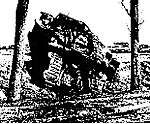
One, tanks are unable to negotiate bad ground; two, the ground on a battlefield will always be bad; three, therefore, tanks are no good on a battlefield.
This was not an uncommon sentiment with many British officers in the earlier years of WWI, and may have resulted in the planned offensive at Cambrai being rejected by GHQ, were it not for the support of Generals Byng and Haig. Haig in particular saw Cambrai as a win-win situation … if the offensive worked, it would raise morale, both of his troops and the home front, after the recent disaster at Passchendaele. And if it didn’t work, then the Tank Corps could be blamed for not fulfilling its promises. What nobody but Brigadier-General Charteris, Haig’s soon-to-be-ex Chief of Intelligence, knew was that the Germans had just reinforced the Cambrai area with three fresh divisions from the Russian front.
Cambrai was in a quiet sector, seven miles behind the Hindenberg Line. It was a region of open, rolling countryside and firm ground that had seen little fighting. The Germans considered their defenses to be impregnable. They were up to five miles deep, with three lines of larger-than- normal trenches designed to foil tanks, and barbed wire entanglements at least 50 yards thick. The plan was to break through the Hindenberg Line along a six-mile front with three brigades of Mark IV tanks (these were basically identical to the original Mark I tanks, except that the armor was 50% thicker) and six infantry divisions, with support from another two divisions and three more divisions in reserve.
In addition, five cavalry divisions were detailed to exploit the gap and isolate Cambrai. Supporting the attack were 1,003 guns and 14 Royal Flying Corps squadrons with 289 aircraft.
A total of 476 tanks were to be involved, consisting of 378 fighting tanks, 32 tanks designed to pull barbed wire out of the way, 54 supply carriers, nine wireless tanks, one telephone cable laying tank and two bridge layers. Each fighting tank carried 1.5 ton fascines (10 foot bundles of brushwood held together by heavy chains) which could be dropped into a trench to form a bridge.
They operated in sections of three.
- The first tank reached the first trench, dropped its fascine, crossed the trench and then moved along the trench to clear it out.
The second tank proceeded to the second trench and did the same thing, and the third tank did the same for the third trench.
By then, the first and second tanks met up with the third and they proceeded into the open country beyond
At this point, Haig’s plan was a bit vague (the offensive was designed to destroy or capture enemy resources rather than to capture territory), but conformed to his doctrine of attacking the German flanks after a breakthrough and rolling up the front. The attack on the Hindenberg Line was a complete success, “almost a cake-walk” according to one of the tankers. “The infantry had walked behind the tanks smoking and with practically nothing to do except mop up a few dugouts”. It was also a most unexpected and surprising success for GHQ. Many commanders refused to believe it and waited for confirmation of reports from the front. Furthermore, the Cavalry Corps HQ was five miles behind the front line, and by the time orders went out for the cavalry to advance, the momentum of the attack had faltered.
As Smithers noted, “The cavalry performed its now customary function of cluttering up all the roads in rear that were urgently needed for the passage of supplies and ammunition.”
Not all sectors of the attack front were successful. The 51st Highland Division’s commander, Major-General “Uncle” Harper, did not trust tanks. Instead of keeping his men in files close behind the tanks to deal with any German artillery, he ignored orders and had his men follow the tanks 100 yards behind. The tanks were destroyed by artillery before the 51st reached them, the German infantry had regrouped and put up stiff resistance, and the cavalry exploitation was delayed yet again.
By the night of 20 November, 179 of the 378 fighting tanks were out of action, and the remainder were in need of maintenance. On the 22nd, the British attack resumed, but by the 29th there were not enough reserves to continue, and the offensive was called off. On the 30th, while the British were withdrawing to prepared positions, eight German divisions, including the units specially trained in infiltration tactics, counter-attacked, finally stopping on 7 December only because of a snowstorm. They were back at the start line.
Shortly after, there was a public outcry in England, and a Court of Enquiry which whitewashed the generals and put most of the blame on the junior officers, NCOs and men. But not on the tanks.
Back to Simulacrum Vol. 2 No. 3 Table of Contents
Back to Simulacrum List of Issues
Back to MagWeb Master Magazine List
© Copyright 2000 by Steambubble Graphics
This article appears in MagWeb (Magazine Web) on the Internet World Wide Web. Other military history articles and gaming articles are available at http://www.magweb.com